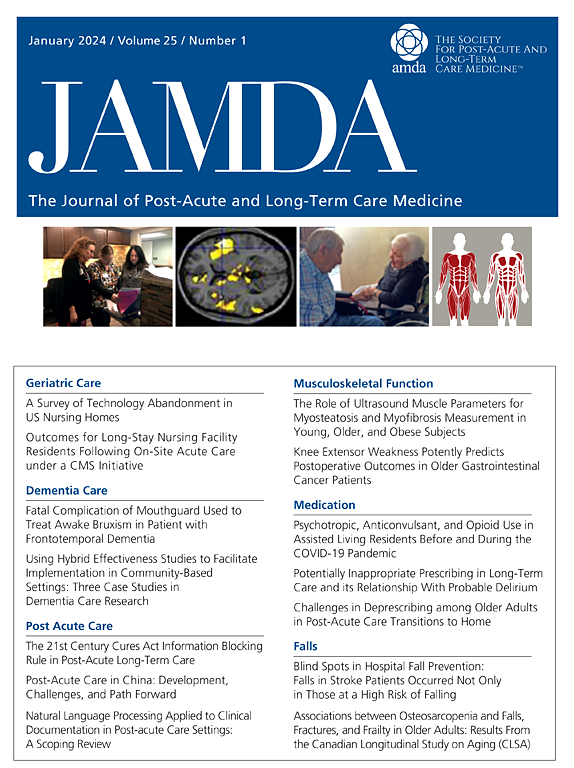对全国医疗保健数据进行流程挖掘,以发现老年人的患者旅程。
IF 4.2
2区 医学
Q2 GERIATRICS & GERONTOLOGY
Journal of the American Medical Directors Association
Pub Date : 2024-11-04
DOI:10.1016/j.jamda.2024.105333
引用次数: 0
摘要
目的:了解老年人使用医疗保健服务的纵向模式对于设计有效的患者旅程和加强不同医疗机构之间的医疗协调至关重要。本研究旨在揭示老年人最常见的患者旅程:这项探索性研究使用流程挖掘技术分析了2017年至2019年的全国医疗保健数据,重点关注荷兰老年人(年龄≥65岁)的患者护理历程:数据来源于荷兰统计局,涵盖截至 2017 年 1 月 1 日年龄≥65 岁的所有居民。数据包括 2017-2019 年期间各种医疗机构的医疗使用申报。如果患者旅程的起始点是确定的,则只选择患者旅程:对数据进行严格的预处理、合并和过滤,以创建适合流程挖掘的单一事件日志文件。根据年龄和用药情况对患者进行分类,并分析患者旅程的差异。流程挖掘技术生成的可视化图表说明了护理形式之间的联系以及一种形式的变化对其他形式的影响:该研究包括 3,177,203 名 65 岁及以上的患者,其中 44% 的患者在 2017-2019 年期间经历了一次或多次患者旅程,共计 2,469,663 次旅程。大多数老年人的护理旅程简单而短暂。最频繁的前 10 个旅程有 4 个或更少的护理形式,65 岁以上人群 95% 的旅程和 85 岁以上人群 90% 的旅程有 4 个或更少的护理转换。长期护理形式,如家庭护理、个人护理和长期护理,占据了在系统中花费的大部分时间:这项开创性的研究利用过程挖掘表明,大多数老年人往往有直接的医疗保健需求,通常涉及急诊科和住院治疗。然而,人口中还有一小部分人需要更复杂、更长时间的医疗服务,尤其是 85 岁以上的老年人。减少这部分人群的转院次数,虽然影响的人数较少,但可能会对整个系统产生较大的影响。本文章由计算机程序翻译,如有差异,请以英文原文为准。
Process Mining on National Health Care Data for the Discovery of Patient Journeys of Older Adults
Objective
Understanding the longitudinal patterns of health care utilization among older adults is crucial for designing effective patient journeys and enhancing care coordination across settings. This study aims to uncover the most common patient journeys of older adults.
Design
This explorative study used process mining techniques to analyze national health care data from 2017 to 2019, focusing on patient care journeys of older adults (aged ≥65 years) in the Netherlands.
Setting and Participants
Data were sourced from Statistics Netherlands, encompassing all residents aged ≥65 years as of January 1, 2017. Health care usage declarations from various care settings during 2017-2019 were included. Patient journeys were exclusively selected if their initiation points were certain.
Methods
Data underwent rigorous preprocessing, merging, and filtering to create a single event log file suitable for process mining. Patients were categorized by age and medication use, and differences in patient journeys were analyzed. Process mining techniques generated visualizations illustrating the connections between care forms and the impact of changes in one form on others.
Results
The study included 3,177,203 individuals aged 65 years and older, with 44% experiencing 1 or more patient journeys totaling 2,469,663 journeys in 2017-2019. Most care journeys for older adults were simple and short. The top 10 most frequent journeys had 4 or fewer care forms, with 95% of journeys for the 65+ population and 90% for the 85+ population having 4 or fewer care transitions. Long-term care forms, such as home care, personal care, and long-term care, accounted for the majority of time spent in the system.
Conclusions and Implications
This pioneering study used process mining to show that most older adults tend to have a straightforward health care need, often involving the emergency department and hospitalizations. However, a smaller group among the population requires more complex and prolonged care, especially in the 85+ population. Reducing the number of transitions for this population, although impacting fewer people, might result in a larger effect on the overall system.
求助全文
通过发布文献求助,成功后即可免费获取论文全文。
去求助
来源期刊
CiteScore
11.10
自引率
6.60%
发文量
472
审稿时长
44 days
期刊介绍:
JAMDA, the official journal of AMDA - The Society for Post-Acute and Long-Term Care Medicine, is a leading peer-reviewed publication that offers practical information and research geared towards healthcare professionals in the post-acute and long-term care fields. It is also a valuable resource for policy-makers, organizational leaders, educators, and advocates.
The journal provides essential information for various healthcare professionals such as medical directors, attending physicians, nurses, consultant pharmacists, geriatric psychiatrists, nurse practitioners, physician assistants, physical and occupational therapists, social workers, and others involved in providing, overseeing, and promoting quality

 求助内容:
求助内容: 应助结果提醒方式:
应助结果提醒方式:


